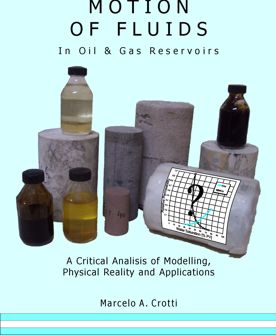

MOTION
OF FLUIDS
in Oil & Gas Reservoirs
The following introductory comments were made by some of the conspicuous reservoir engineers who helped the author with the final corrections of the original “manuscript”.
You do not know what you see, but you see what you know.”
Jean Piaget
Piaget’s quote summarizes my feelings when faced with the ideas presented in this book. For some time I had been feeling that something “was not working" when trying to describe fluid motion in the reservoir through relative permeability curves. However, I was not able to identify where the difficulty was.
When I went over the differentiation made by Marcelo among injection, conduction and production, I felt he had become aware of something that has always been in front of our eyes but has remained unobserved. This re-evaluation of the difference among the mentioned three concepts sheds light on a problem that has been repeatedly glimpsed and evaded.
The most outstanding merit of this book lies in the identification of the problem; and, above all and for the first time, its straightforward proposal of a different solution where formerly “only patches were placed.”
Norberto Galacho.
Really good! As the time this book reaches readers, we will be able to assert that “Reservoir Engineering is possible in Argentina”. It may be the end of pure empiricism exalted to exacerbation and the beginning of an “era” among us (Reservoir Engineers), of analysis, discussion and reflection. There is no doubt that Marcelo’s ideas will at least cause a conflict in the analyst or reader, who will have to discuss old paradigms and decide if a change is needed. From my point of view, the position does not imply “not to measure” but to know “what for”, “how to measure” and finally “how to use measurements”. That is the challenge.
Miguel Angel Laffitte
In spite of the fact that the relative permeability concept is deeply rooted and seems natural, it is in fact a simple macroscopic approximation to a complex microscopic problem. Marcelo argues more about its use or application to explain the displacement phenomena than about the concept itself. However, it is the starting point on the road to search for different formulations, whose application requires only an appropriate description of the reservoir (including all the inherent complexities) and the fluids, and not the necessarily assumptions or simplifications, which, in general, are not applicable.
I hope and wish this is our opportunity to start introducing a great change, which would be feasible due to the full participation and cooperation of those people interested in the topic.
Antonio A Paradiso
Dear readers:
Hold on! This is an amusing and clear book, however its reading is hard and not
suitable for dogmatic people. It is difficult to say how much you agree with
this book. Perhaps you discover things that you looked at years ago, but you
were unable to see; or you may disagree with others. Many times you will
be unable to say whether you agree or not, and you may need to postpone the
judgment till knowledge is consolidated.
Marcelo suggested to “beat hard” the relative permeability curves, but he goes further. He questions deeply rooted issues, such as numeric simulation itself. I can not say how much I agree and I must postpone my judgment. Hold on!
Juan Rosbaco

(*)shipping cost not included.
Book Request: infolab@inlab.com.ar
Questions to the Author: mcrotti@inlab.com.ar
Back to the Reservoir Enginnering Forum
---- Reservoir Engineering ----
WHO IS THIS BOOK INTENDED FOR? 5
BOOK ORGANIZATION 6
ACKNOWLEDGMENTS 6
THE RELATIVE PERMEABILITY CONCEPT 8
PERMEABILITY OF POROUS MEDIA 8
SIMPLIFIED MODEL OF POROUS SYSTEM 8
RELATIVE PERMEABILITY 10
Biphasic Flow 10
Case I: Low rate displacement in water wet system 10
Case II: Oil wet displacement. 13
Case III: Displacement under gravity segregated flow conditions. 14
Case IV: Displacement under gravity segregated flow conditions with random distribution 14
A more General Case 15
REMARKS 15
MAIN CONSEQUENCES 16
SUMMARY OF CHAPTER I 16
THEORY AND APPLICATIONS 17
CHAPTER CONTENTS AND OBJECTIVES 17
PROCEDURES, NUMBERS AND CONCEPTS 17
Experimental Data 17
Plots 19
Fitting Experimental Data 20
A Direct Calculation 21
Observations: 21
Results 22
Numerical Simulation of the Displacement Test 26
FAQs 28
SUMMARY AND CONCLUSIONS 30
REFERENCES 30
APPENDIX 31
Measurements and Calculation of Relative Permeability Curves 31
Theory 31
The Quality of Measurements 31
What Happens During the Water Displacement Test? 32
Water and Oil Production Rates 33
Numerical Simulation Using a Spreadsheet 37
INJECTION, CONDUCTION AND PRODUCTION 39
MULTIPHASE FLOW 39
Relative Permeabilities 39
Injection, Conduction and Production 40
Validity of the Relative Permeability Concept 40
Undefined Variables 41
Historical “Solutions” 41
The Practical Problem 42
FAQs 43
SUMMARY AND CONCLUSIONS 43
REFERENCES 44
INCONSISTENCIES 45
FIRST EXAMPLE. THE FRACTIONAL FLOW CURVE AND THE RELATIVE PERMEABILITY PSEUDO FUNCTIONS 46
Properties of Fractional Flow Curves 47
Simplification of Complex Systems 47
Homogeneous Block under Predominant Gravity Forces 48
SECOND EXAMPLE THE SAME RELATIVE PERMEABILITY AND TWO DIFFERENT PRODUCTION HISTORIES 51
Case I: Non-communicated Layers (no cross-flow). 52
Case II: Interconnected Layers. Full Gravitational Segregation. 54
Further Explanations 55
Both models in the same reservoir 55
Minor differences 55
Why M=1? 55
Generalization 55
FAQs 55
SPECIAL COMMENTS 56
Gravity and Capillary Forces in Darcy’s Equation 56
The Fractional Flow Curve and Capillary Forces 57
Average and Point Saturations 57
Continuous and Discontinuous Values 57
Volumetric Properties 58
SUMMARY AND CONCLUSIONS 58
REFERENCES 58
HETEROGENEITIES AND AVERAGES 59
FLUIDS FLOW IN HETEROGENEOUS SYSTEMS 59
Case I. Unsteady-State Flow 61
Water Saturation (Sw) 62
Relative Permeabilities 62
Summary 64
Remarks 64
Case II. Steady-State Flow 64
Summary 66
Comments 67
ANALYSIS OF RESULTS 67
Mathematical Average 67
Physical Average 67
A Conceptual Answer 68
FAQs AND COMMENTS 68
SUMMARY AND CONCLUSIONS 69
REFERENCES 69
NUMERICAL SIMULATION 70
FIRST EXAMPLE – CELL SIZE 70
Displacement diagram 70
Fractional Production Curves 72
Analysis and First Conclusions 74
Observation 75
FAQs 77
SECOND EXAMPLE – CELL LOCATION 77
Additional Analysis and Conclusions 80
Observations: 80
FAQs 80
SUMMARY AND CONCLUSIONS 82
REFERENCES 82
SUPPLEMENTARY DISCUSSION 83
Tending to an infinite number of cells. 83
Vertical gridding and SPC 86
SPECIFIC PRODUCTIVITY 90
VISCOUS-DOMINATED DISPLACEMENT IN HOMOGENEOUS LINEAR SYSTEMS 90
VISCOUS-DOMINATED DISPLACEMENTS IN TWO-DIMENSIONAL HOMOGENEOUS SYSTEM 91
TWO-DIMENSIONAL HOMOGENEOUS GRAVITY-DOMINATED SYSTEM. 93
GENERAL SOLUTION 94
FAQs 94
SUMMARY AND CONCLUSIONS 95
REFERENCES 95
EPILOGUE 96
A BIT OF HISTORY 96
THE WAY TO GO 98
FINAL WORDS 99
SUPPLEMENTARY TOPICS 100
RESIDUAL OIL SATURATION 100
Wettability 100
The Displacement mechanism 101
Initial Water Saturation 101
Extrapolations 102
IRREDUCIBLE WATER SATURATION 102
Scarcely laminated Average Permeability Samples (between 20 and 200 mD). 102
High Permeability Samples (more than 500 mD), or Average Permeability, very Laminated Samples. 102
Scarcely Permeable Samples (less than 20 mD). 103
Conclusions 103
Scarcely laminated average permeability samples (between 20 and 200 mD). 103
High permeability samples (more than 500 mD) or average permeability and very laminated samples. 103
Scarcely permeable samples (less than 20 mD). 103
CORRELATIONS 103
VISCOSITY RATIO 104
THREE-PHASE RELATIVE PERMEABILITIES 104
IMPLICIT CALCULATION METHOD 105
WETTABILITY 106
The Essential Concepts 106
Lab Measurements 106
Consequences 107
Edge Effects. 107
Relative Permeabilities. 107
How to Introduce Wettability in Reservoir Models? 107
REFERENCES 108
CONTENTS 109